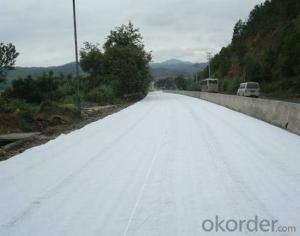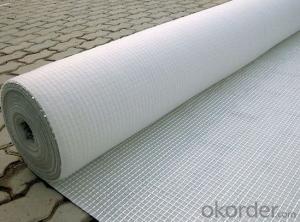Wf200 100% Polyester Filament Civil Non-Woven Geotextiles Fabric in China
- Loading Port:
- China main port
- Payment Terms:
- TT OR LC
- Min Order Qty:
- 1000 m²
- Supply Capability:
- 1000000 m²/month
OKorder Service Pledge
OKorder Financial Service
You Might Also Like


Product Introduction
Type:
Geotextiles, Nonwoven Geotextile woven Geotextile
Place of Origin:
Shandong, China (Mainland)
Brand Name:
CMAX
Model Number:
CMAX-S001
Geotextile Type:
Non-Woven Geotextiles Woven Geotextiles
Features and Benefits
Nonwoven structure, providing excellent surface friction and built-in elongation
Effective filter, with tight pore size (AOS=70) and high permittivity
High tensile strength, with excellent puncture and tear resistance
Range from 3.2 oz/sy (109g/sm) – 16.0 oz/sy (543g/sm)
Thick structure, allowing cushioning and lateral gas and liquid transmission
Assembling is possible at almost any weather conditions. There are no big difficulties while the laying out of the material due to the following features: material rolls are not big, which reduces transportation and storage costs as well as labor costs; the material does not water permeable; while application in humid conditions the roll weight does not change; it is not permeable for plant roots, is a good protection from gnawing animals; acid and alkali resistant, etc. the material exactly repeats the base molding and does not require any fixing and fastening joints.
Our Service
1.On a regular basis or as per your request,we entrust national testing agencies to conduct quality inspections
2. Strictly in accordance with the ISO9001-2008 international quality system standard,we monitor and manage the whole process throughout production,quality testing,and measurement to ensure product quality
3. For quality-related construction delay or substandard construction(except for damage or losses due to customer’s responsibility or irresistible natural disasters),we have refunding,replacement,and repair services.We will respond to customers’ feedbacks on quality issues within 24 hours.
After-sales service
1.In order to provide customers with comprehensive technical support,we will provide technical and other related information upon request in a timely manner.
2.In required,we will appoint specialized technicians to the construction site to give technical trainings to construction people,and offer technical guidance throughout the whole construction process.
3.For damage due to shipment and delivery,after we receive the complaint,we will check the issure through provided pictures and videos.If our responsibility is confirmed,we wil offer free replacement.
4.When the construction is completed,as your request,our technical staff may participate in the final acceptance.
FAQ:
Q: What kind of payments does jenor support?
A: T/T, L/C, Cash are accepted.
Q: Do you charge for the samples?
A: Accordeing to our company policy, the samples are free, we only charge the freight fee. And we will return the freight fee during the next order.
Q: Can you produce according to customers' design?
A: Sure, we are professional manufacturer, OEM and ODM are both welcome.
Q: Do you have other products?
A: Yes, please check the pictures:
- Q: How do geotextiles help with bridge abutment protection?
- Geotextiles help with bridge abutment protection by acting as a barrier to prevent soil erosion and stabilize the surrounding soil. They provide reinforcement and filtration, effectively distributing the load and reducing the risk of settlement and structural damage to the bridge abutments. Additionally, geotextiles can enhance drainage and prevent the clogging of drainage systems, further safeguarding the bridge abutments from water-related issues.
- Q: How do geotextiles improve the performance of geosynthetic clay liners?
- Geotextiles improve the performance of geosynthetic clay liners by providing additional reinforcement and stability. They act as a separation layer, preventing the mixing of different materials, such as clay and other fill materials. Geotextiles also enhance drainage capabilities by allowing water to flow through while retaining fine particles. Ultimately, they improve the overall strength, durability, and long-term performance of geosynthetic clay liners in various applications such as landfill liners and erosion control measures.
- Q: How do geotextiles help with slope stabilization?
- Geotextiles help with slope stabilization by providing reinforcement and retaining soil on slopes. They act as a barrier, preventing erosion and the movement of soil particles, while still allowing water to pass through. This helps to maintain the stability of slopes and prevents landslides or slope failures.
- Q: Can geotextiles be used in foundations and retaining walls?
- Yes, geotextiles can be used in foundations and retaining walls. Geotextiles are often used as a separation and filtration layer between the soil and the foundation or retaining wall materials. They can enhance the stability and durability of these structures by preventing soil erosion, improving drainage, and reducing the risk of soil contamination.
- Q: How many grams of geotextiles on the top of the garage
- Drainage board is generally 1000 grams 20MM, geotextiles generally require 250 grams, you need to contact Huazhi geotechnical materials manufacturers to answer your questions
- Q: What is the geotextile material?
- Production of geotextile raw materials are: polyester staple fiber, polypropylene staple fiber, polyester filament, PP flat wire and so on
- Q: How do geotextiles help with soil confinement in erosion control block walls?
- Geotextiles help with soil confinement in erosion control block walls by acting as a barrier that prevents the soil from washing away. These synthetic fabrics are placed between the soil and the block wall, allowing water to drain through but keeping the soil particles intact. This confinement prevents erosion and helps maintain the stability and integrity of the wall.
- Q: Do geotextiles and geogrids do check-in?
- Required, geotextile and geogrid material is qualified. But actually depends on the situation to set.
- Q: Can geotextiles be used for reinforcement of road embankments?
- Yes, geotextiles can be used for the reinforcement of road embankments. Geotextiles are commonly employed in road construction and maintenance to enhance the stability and durability of embankments. They provide reinforcement by distributing loads and reducing settlement, while also improving drainage and preventing erosion.
Send your message to us
Wf200 100% Polyester Filament Civil Non-Woven Geotextiles Fabric in China
- Loading Port:
- China main port
- Payment Terms:
- TT OR LC
- Min Order Qty:
- 1000 m²
- Supply Capability:
- 1000000 m²/month
OKorder Service Pledge
OKorder Financial Service
Similar products
Hot products
Hot Searches
Related keywords






























